Pebble Beach: SSCS’s Upscale Neighbor (Part 1)
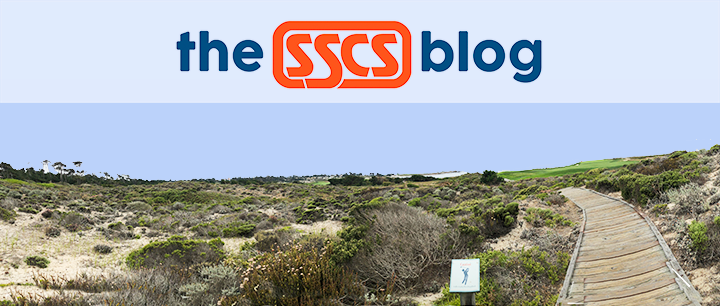 There’s more to the Del Monte Forest than World-Class Golf Courses.
There’s more to the Del Monte Forest than World-Class Golf Courses.
We’ve talked often in this blog about the uniqueness of the surrounding SSCS area. If you need a reminder, here is a list of links to the other posts that do exactly that:
But for today, and the next few weeks, we’re going to take a look around what is perhaps SSCS’s most globally famous neighbor, Pebble Beach, part of the larger Del Monte Forest.
There’s little question that Pebble Beach gets most of its notoriety from its world-class golf courses, eight total including the Pebble Beach Golf Links, The Links at Spanish Bay, Spyglass Hill Golf Course, and Poppy Hills Golf Course. That’s a dense concentration of high profile golf courses for an area approximately 8 square miles. Little wonder Pebble Beach and golf are synonymous.
But as you might expect of a community embedded in a forest looking out over the Pacific Ocean, there’s plenty more a lot to see here. Fortunately most of it can be taken in from Pebble Beach’s most famous thoroughfare, 17 Mile Drive. There are five guard gates that allow entry into the unincorporated community. We’re starting our tour at the Pacific Grove Gate, not only because we use any excuse to visit Pacific Grove, but because this gate sits squarely on 17-Mile Drive.
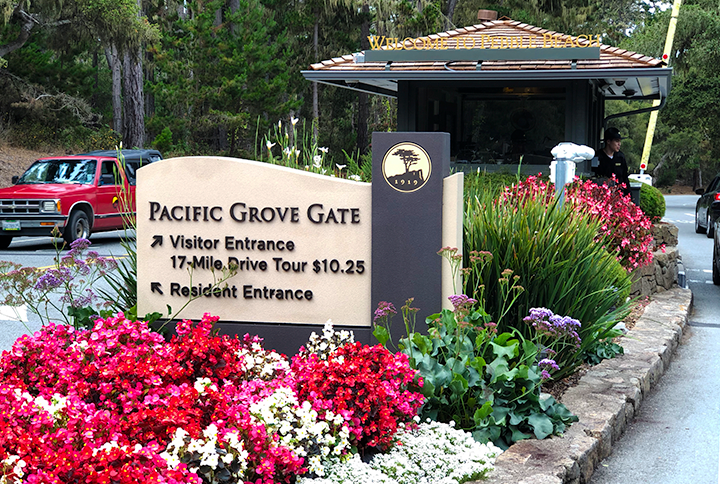 No doubt you noticed the $10.25 entrance fee marked on the sign above, but if you spend $35 on food and keep your receipts, reimbursement is available. Better yet, entrance to Pebble Beach is absolutely free if you bike, walk, or run in. (We’ve engaged in the latter activity dozens of times—sometimes before the sun comes up—as PB is the safest place we’ve ever been in the dark, if you aren’t put off by the occasional rustling of a scraggly, retreating coyote in the underbrush).
No doubt you noticed the $10.25 entrance fee marked on the sign above, but if you spend $35 on food and keep your receipts, reimbursement is available. Better yet, entrance to Pebble Beach is absolutely free if you bike, walk, or run in. (We’ve engaged in the latter activity dozens of times—sometimes before the sun comes up—as PB is the safest place we’ve ever been in the dark, if you aren’t put off by the occasional rustling of a scraggly, retreating coyote in the underbrush).
Pass through the gate and trees rise up on the driver side. On the passenger side, though it may not be apparent immediately because of similar tree cover, lies Spanish Bay (named because of explorer Gaspar de Portala, who landed there in 1769) and the vastness of the Pacific Ocean. The red line below traces the first leg of our journey, the part we’re taking today. Signs along the Drive denote various points of interest. This three-part series will touch on many of them along with a few other, less formally documented sights.
 Our first destination is the Inn at Spanish Bay/the Links at Spanish Bay, a true Scottish links course right on the water, so Scottish that every evening at dusk, a bagpiper comes out on the verandah and plays to “put the golf course to sleep.” That unique sound carries for what seems miles, adding to the allure of the location. While the Spanish Bay environs are certainly a vacationer’s paradise, the property also boasts 80 full time luxury condo residences. The following photo kind of sums up the experience of living on a world-class links course:
Our first destination is the Inn at Spanish Bay/the Links at Spanish Bay, a true Scottish links course right on the water, so Scottish that every evening at dusk, a bagpiper comes out on the verandah and plays to “put the golf course to sleep.” That unique sound carries for what seems miles, adding to the allure of the location. While the Spanish Bay environs are certainly a vacationer’s paradise, the property also boasts 80 full time luxury condo residences. The following photo kind of sums up the experience of living on a world-class links course:
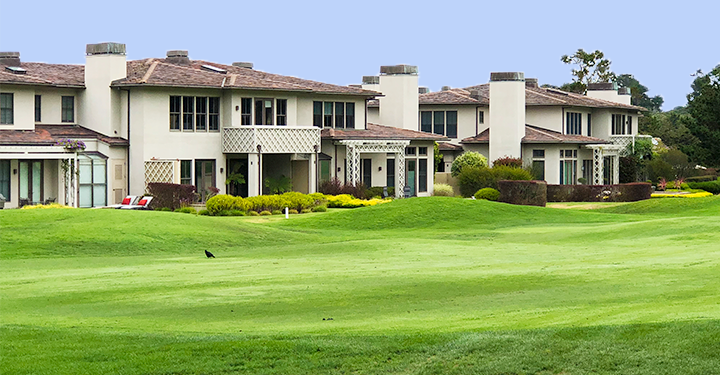 As for visitors, the Inn is modern and comfy, with an understated glamour, but for the purposes of this blog, the most compelling part of the visit occurs when you walk through the lobby and out onto the grounds in the back of the Inn. Among other things, you get a chance to view the panorama that leads off this post, indicative that this is, indeed, a links course. An expansive outdoor patio with fire pits looks out on this scene, which includes the following delightful sculpture, “Afternoon in the Park” by Mark Lundeen. You can see the links rolling out behind it.
As for visitors, the Inn is modern and comfy, with an understated glamour, but for the purposes of this blog, the most compelling part of the visit occurs when you walk through the lobby and out onto the grounds in the back of the Inn. Among other things, you get a chance to view the panorama that leads off this post, indicative that this is, indeed, a links course. An expansive outdoor patio with fire pits looks out on this scene, which includes the following delightful sculpture, “Afternoon in the Park” by Mark Lundeen. You can see the links rolling out behind it.
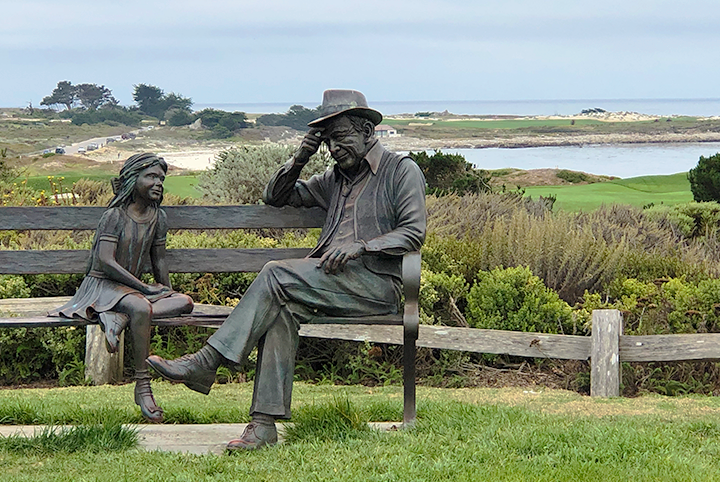 Just so you don’t get the wrong idea, Spanish Bay isn’t some towering palace that clashes with the wildness and beauty of the surrounding area. As is the case with many of the structural developments that you’ll find here, an effort is made to integrate them in the surrounding area, as you can see from following photo, taken looking at the in from the direction of the water. For a stellar destination, it’s quite unobtrusive:
Just so you don’t get the wrong idea, Spanish Bay isn’t some towering palace that clashes with the wildness and beauty of the surrounding area. As is the case with many of the structural developments that you’ll find here, an effort is made to integrate them in the surrounding area, as you can see from following photo, taken looking at the in from the direction of the water. For a stellar destination, it’s quite unobtrusive: As you’ve probably noticed, this part of Pebble Beach is raw and windswept, though no less beautiful for it. While the terrain will change in a few miles (as we’ll see next week), when you pass the Spanish Bay resort it isn’t long until 17-Mile Drive curves sharply and butts up against the water. This makes for great views—some of the best on the drive—and the relatively level dirt paths that parallel the Drive on the ocean side make it perfect for biking and hiking. You’ll see marine birds, wild rabbits, and like we said before, maybe a family of coyotes (“Watch out for the jackals,” a gentleman cyclist from Down Under once warned us, but we knew better).
As you’ve probably noticed, this part of Pebble Beach is raw and windswept, though no less beautiful for it. While the terrain will change in a few miles (as we’ll see next week), when you pass the Spanish Bay resort it isn’t long until 17-Mile Drive curves sharply and butts up against the water. This makes for great views—some of the best on the drive—and the relatively level dirt paths that parallel the Drive on the ocean side make it perfect for biking and hiking. You’ll see marine birds, wild rabbits, and like we said before, maybe a family of coyotes (“Watch out for the jackals,” a gentleman cyclist from Down Under once warned us, but we knew better).
Anyway, let’s take a look at a couple of the highlights of this stretch. First up is Point Joe, site of several historical shipwrecks, and the “Restless Sea” that surrounds it. Both are called out as points of interest on the official 17-Mile Drive tour:
 The Restless Sea is noted because of the non-stop turbulent waters that continually churn at the base of the rocks that mark, for all intents and purposes, Point Joe. This movement doesn’t really translate that well to still photography, so we decided to highlight some of the feathered friends that frequent this section of the Drive, the end point of our tour for this week.
The Restless Sea is noted because of the non-stop turbulent waters that continually churn at the base of the rocks that mark, for all intents and purposes, Point Joe. This movement doesn’t really translate that well to still photography, so we decided to highlight some of the feathered friends that frequent this section of the Drive, the end point of our tour for this week.
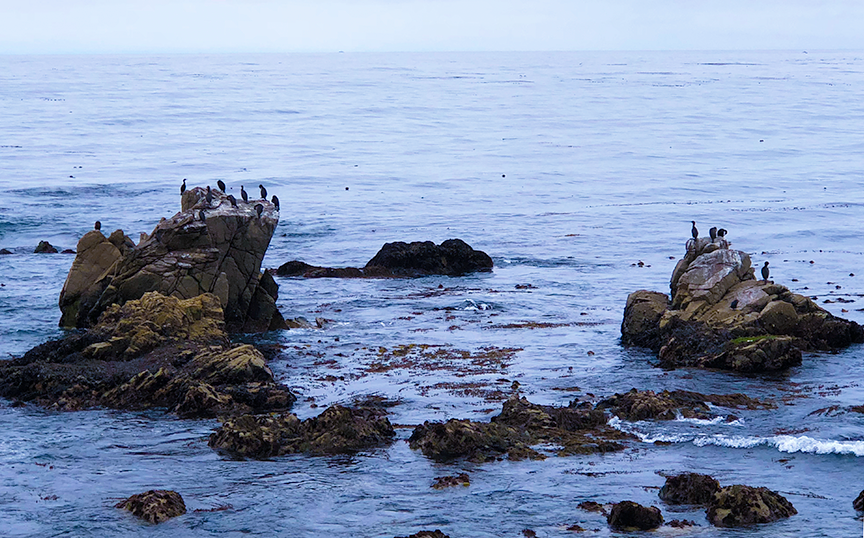 Next week we’ll go further down the road, eventually turning away from the sea to head inland and up the hill to the “interior” of Pebble Beach, a heavily wooded area that contrasts sharply with what we’ve seen today and is known for its own distinctive set of attractions. Be sure to return next Thursday to see what we mean.
Next week we’ll go further down the road, eventually turning away from the sea to head inland and up the hill to the “interior” of Pebble Beach, a heavily wooded area that contrasts sharply with what we’ve seen today and is known for its own distinctive set of attractions. Be sure to return next Thursday to see what we mean.
Before we leave, you might be wondering what lies across 17-Mile Drive from the Restless Sea, Point Joe, and all the rest of it. The answer is the Monterey Peninsula Country Club, which boasts two courses. What you see from the street is the West Course. Note the homes in the background. We bet they’re pretty nice.
Click here to continue to part 2.

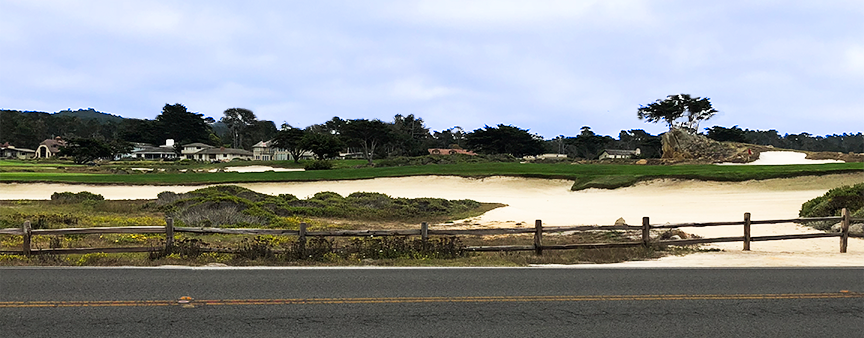




Recent Comments